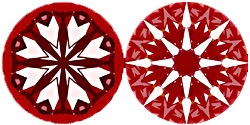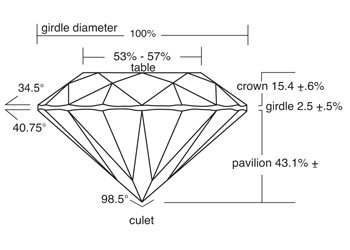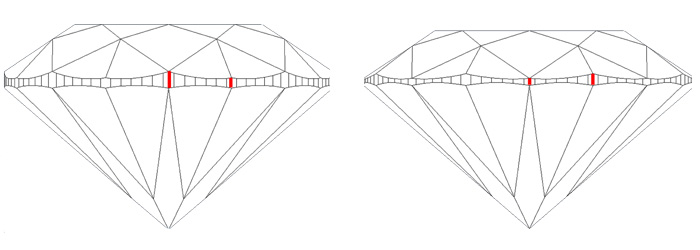Diamond Buying 102: The Von Bargen’s Difference
At Von Bargen’s we go way beyond the 4’c (Cut, Color, Clarity, Carat) to ensure that you’re getting a diamond that performs to your expectation. Diamond performance is essential to understanding the value and ultimately what price you’re going to pay for a diamond.
You’ve learned the 4c’s and that is an excellent start, but there is more to know in order to get a spectacular diamond at a great value. Our goal is to educate you so you understand what impacts price and performance.
Beyond the 4C’s – What to Take into consideration when selecting your diamond:
Man vs Nature
Let’s start here. What Mother Nature does to a diamond impacts how rare a diamond is, the rarer an attribute, like color or clarity, the higher the price.
Mankind cuts diamonds so that they sparkle, the better the cut, the higher the performance (sparkle and scintillation) and the higher the price. A better cut takes more raw materials (diamond rough). You can also purchase raw or uncut diamonds.
The Perfect Cut
You want a diamond with high performance, one that sparkles. Our best performing diamonds start with an Ideal Cut Grade (AGS) or an Excellent Cut Grade (GIA).
The Cut of a diamond can affect the value of a diamond up to 50%. Yes pause and think about that. At Von Bargen’s, cut is the most important factor in determining a diamond’s performance, beauty and ultimately its value. Comparing a diamond that is smaller in size but cut ideally next to a non-ideal cut is interesting; to the naked eye the smaller stone can appear larger.
ASET® results
ASET (Angular Spectrum Evaluation Tool) simply put, diamonds appear bright if they are cut to draw light from the brightest areas of the world. Among other things, this idea implies that the brightest diamonds will exhibit a minimum amount of light leakage and will not draw too much light from high angles where the observer’s head can obscure light sources.

ASET (Angular Spectrum Evaluation Tool)
The ASET tool helps us discover light leakage, proportions and performance. The left image is a good result and the right image is a bad result.
Internal Symmetry (Hearts and arrows)
Hearts and Arrows scopes allow us to view the inner optical symmetry of a diamond. This is a simple test that yields a big return when reviewing diamonds.
The right image is an example what they look like.

Table Size & Depth Dimensions
Think of the flash of light versus the spectrum light (light from prism). Varying a diamond’s table and depth can give you more white light (flash) but potentially less spectrum light (fire – red, greens, blues, etc) or the inverse can be true.
We balance the table to depth ratios so you get the optimal balance of the white light (flash) and the spectrum light (fire).

Crown & Pavilion Angles
Crown or pavilion angles that are too shallow or too steep will impact the diamond’s light performance, specifically white light and spectrum light. This topic gets pretty technical, but for now what you need to know is that these angles matter. People have written theses on this subject alone. We’ll make sure you’re getting the right angles.
Rating for Color & Clarity Grading
Not all color and clarity grades are equal, especially among different laboratories. We find some SI1’s are better than other SI1’s by the nature, color, quantity or location of the inclusions. Did you ever get a grade in school that just wasn’t fair? Diamond grading can be like this too.
Not all grading is an exact fact – grading is an opinion. So while it may seem confusing, there is a range within the color and clarity grades.

Consider each rating like a grade in school. If you get a grade, you can get an A+, A or A-.
This holds true for color and clarity.
You can have a color grade for E that is an E+, E or E– color, and you can have a clarity grade for an SI1 that is SI1+, SI1 or a SI1– . This terminology is commonly used in the trade.
We validate the grading from independent labs to ensure their opinion matches ours and select only the finest diamonds within each grade. Our current rejection rate is about 38%.

The Diamonds Polish
Excellent or Ideal polish is critical in achieving clear dispersion, sharp scintillation and maximum brilliance. It takes time to polish the facet to a bright and smooth finish.
Just as minute scratches can dull a glass surface, a poor polish on a diamond can reduce the brightness of its sparkle.
The Diamonds Symmetry
The light performance of a diamond depends on the cutter’s decision on the angles and placement of the facets and the skill to place those facets at precise angles.
We’ve reviewed the internal symmetry with the hearts and arrows diagram. This symmetry refers to the external symmetry – how well the facets come to a point around the intersection of the diamond’s facets.
Mis-aligned facets cause light loss.

Girdle Thickness
Guess where most of the diamond’s weight is… yep, around the girdle.
Cutters know how to ‘swindle’ proportion sets to maximize weight at the expense of beauty. They choose to retain the weight of a diamond while invariably sacrificing its optical performance. The result is that you pay more for a diamond that looks smaller and underperforms.

On the left is a chart that shows how when girdle thickness increases, weight increases but performance remains the same. You’ll pay a lot more for the diamond on the far right and it won’t necessarily perform better.
Girdle thickness increases in the diamonds from left to right, but their performance is relatively equal.
In this example below, the illustration on the left results in a heavier diamond with less performance. Yes, you’re paying more for less!

In this example on the left, the illustration on the left results in a heavier diamond with less performance. Yes, you’re paying more for less!
To help put the sensitivity of a diamond’s weight into perspective for you, a dollar bill weighs about 5.0 carats. Small adjustments to a diamonds cutting can yield a big impact to the overall weight and final price to you, the consumer.
Fluorescence
In colorless or near colorless diamonds, we recommend no fluorescence, albeit there can be exceptions depending on the diamond’s shape and the customer’s preference.
On a very sunny day if your diamond has fluorescence it makes the stone look hazy. We call these disco diamonds too – if you’re in a club and see someone’s diamond glowing under the black lights, it probably has strong fluorescence.
Clarity Enhancement
This refers to laser drilling and then fracture filling a diamond with glass. Okay, maybe it’s not actually glass but whatever they inject into the diamond is not okay with Von Bargen’s.
We do not sell clarity enhanced diamonds. To us it’s like selling a new car that was damaged during delivery and then fixed by an auto body shop. Sure it looks pretty good now but that repair could raise its head down the road.

AGS or GIA lab report
AGS and GIA are the only labs to use in our opinion because they are the most consistent, stringent and respected for their reporting. We use these labs to qualify diamonds for our review process. Of the diamonds we review, approximately 38% are rejected.
Culet Size
We try to avoid large, very large or extremely large culets.
Inspected by a Von Bargen’s Diamond Buyer – We Guarantee it.
At Von Bargen’s we sell only the finest diamonds available, at exceptionally competitive prices. We have a very stringent process in place to ensure that.
Each individual diamond we carry is scrutinized and hand-selected for use in our jewelry.
The best of these, The Legacy Diamonds of Von Bargen’s, are among the most rare and exceptional diamonds in the world.
In order for a diamond to be selected as one of our Legacy Diamonds, they have to meet a very specific set of criteria.
Only Ideal cut, round brilliant diamonds are considered. And they must have a GIA or AGS report. And of those, we select only the diamonds that truly exemplify the very best performance – that have the most sparkle and brilliance. This means that less than .05% of the diamonds in the world qualify to become one of our Legacy Diamonds.
With these criteria, what we have done is join the highest standards of diamond cutting with the highest standards for performance. When that happens, the result is a diamond that is absolutely breath-taking, brilliant like no other. Because that’s what’s really most important when you’re choosing a diamond – how it looks. How beautiful is it?
A lot of these criteria start to blend into each other and it’s our job, we’ll do the heavy lifting and sift through this for you. We want you to understand that these elements have a great impact to a diamonds performance and its overall value. We’ll work with you to determine what attributes mean the most to you to ensure you’re getting the very best performing diamond at the absolute best price. We guarantee it.
Watch the undercover report, be informed.
You cannot inspect a diamond from a lab report alone. It should be reviewed by someone you trust. And that person should be able to help you with the attributes outlined above.
We are available for any question you may have. Give us a call at the number bellow or leave us a message via the Live Chat.

